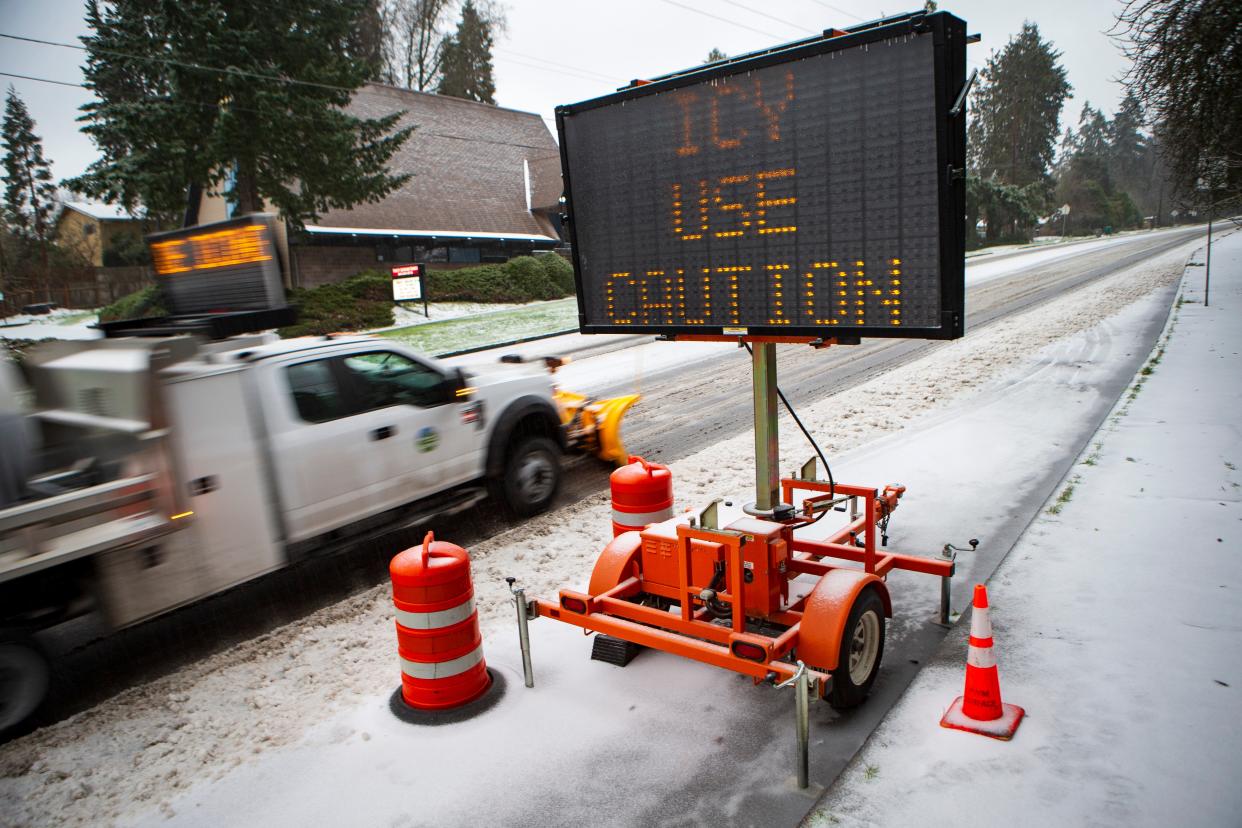Driving in the snow? What to do if you're stuck in your car during a winter storm
Driving is not recommended and can pose significant risks in weather conditions like those facing parts of Oregon this week. Freezing rain and snow have left many roads covered in ice, and the hazards of driving in such extreme weather are obvious.
Still, as reported by the U.S. Department of Transportation Federal Highway Administration, there is an average of more than 1.25 million weather-related crashes on U.S. roads annually.
While it is advisable to avoid driving in adverse weather, the reality is that snowy and unpredictable conditions can catch even the most cautious drivers off guard.
It helps to be adequately prepared. The following practical tips, as provided by the Oregon Department of Transportation, can help to make your trip safer:
How to find travel information, road conditions
For up-to-date travel conditions, visit TripCheck, ODOT's mobile-friendly travel information website. The site features maps, alerts and access to a network of more than 700 cameras located across the state.
Travelers also can dial 511 to get access to the same road and weather information. Most wireless companies in Oregon provide 511 service. If you cannot use 511, call toll-free 800 977-ODOT (6368) for road and weather information. Outside Oregon, dial 503-588-2941.
Use TripCheck TV to create a custom display of road condition information and camera images.

How to find alternative travel options
To travel by bus or other mode of alternative transportation, Oregonians can plan a trip using Get There Oregon. Enter your starting and ending locations and select the transit option to find information on routes.
Amtrak Cascades train and Cascades POINT bus offer service from Eugene to Portland to Seattle to Vancouver, B.C. POINT intercity bus service makes connections all over the state.
Driving in the snow
Driving in the snow requires a certain set of driving skills that some Oregonians rarely get to use. Here are some things to keep in mind:
Check road conditions on your route before you go at TripCheck or by dialing 511. Plan your trip accordingly.
Allow extra time to get where you’re going. Travel is going to be slow.
Allow extra stopping distance. There is less traction on slick, snowy roads.
Brake gently to avoid skidding or sliding. If the wheels lock up, ease off the brakes.
Carry chains and know how to use them.
Make sure your vehicle is in top operating condition, with clean headlights, good brakes, working windshield wipers and good tires.
Slow down when approaching off-ramps, bridges and shady spots where the snow often lingers longer.
Turn on your headlights to increase your visibility.
Be prepared for delays. Make sure you have water, blankets, a full tank of gas and plenty of patience!
If you feel tired or if road conditions get rough, don’t be afraid to stop for the night.

Driving on ice
Bridges and overpasses are the most dangerous parts of the road in the winter. They're the first to freeze and the last to thaw because they’re built of concrete, which doesn’t retain as much heat as other materials. Be safe while driving on icy roads by remembering the following:
Turn off your cruise control, be alert and drive cautiously.
Roads that are wet or have fresh snow, packed snow, or ice have varying degrees of traction. Adjust your speed to match road conditions accordingly.
Increase your distance from vehicles in front of you. Allow about three times as much space as usual.
If your vehicle suddenly feels like it’s floating, gradually slow down. Tap on your brakes gently; don’t slam them.
Changes in elevation can drastically affect road and weather conditions. Watch for icy spots, especially in shaded corners.
Avoid driving through snowdrifts — they may cause your vehicle to spin out of control.
Blowing powder or dry snow can limit your visibility, especially when approaching or following trucks or snowplows. Keep your distance to avoid being blinded by blowing snow.
Look for signs of ice on windshield wipers, side view mirrors, road signs, trees or fences. If ice has formed on any of these things, it may be on the road as well.
Using tire chains
Check your vehicle operator’s manual for the right type and size of chains to purchase. Follow the manufacturer’s installation instructions.
Don’t deflate tires to install chains.
Don’t wait until you lose control of your vehicle before chaining up.
Pull over to a safe and level area to mount or remove chains.
Pull over in a safe place and retighten your tire chains after you have driven a short distance.
Pull over and stop immediately if any part of your chain fails or comes loose.
Don’t drive faster than 30 mph when using chains. Accelerate and decelerate slowly. Avoid spinning or locking your wheels.
Remember: you can slide even with chains, so drive carefully and slowly.
This article originally appeared on Register-Guard: How to drive in the snow, ice: Tips for safe winter travel
